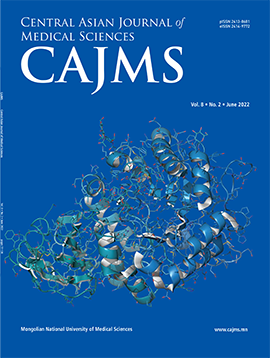Osteoporosis in Mongolian Population: Prevalence and Risk Factors
DOI:
https://doi.org/10.24079/cajms.2017.11.009Keywords:
Osteoporosis, Prevalence, Mongolia, T-scoreAbstract
Objectives: The purpose of this study was to evaluate the prevalence of osteoporosis and investigate some of its risk factors among Mongolian adults. Methods: The subjects comprised of 2001 adults (age ranged from 20 to 87) were recruited from 5 ecological zones of Mongolia. After applying exclusion criteria, 1990 subjects were selected. Speed of sound (SOS) ultrasonic bone mineral density was measured in the distal one third of radius of the non-dominant arm using the Sunlight Omnisense (Sunlight Medical, Rehovot, Israel). The data were used to calculate mean SOS and T-score by WHO osteoporosis criteria. Results: The average age was 49.1±13.5 (men: 48.6±14.6, women: 49.4±13.0). The prevalence of osteoporosis in men and women from 20-35 years of age was 4.7% vs 6.2%, from 36-45 years of age was 7.2% vs 8.0%, from ages 46-55 was 11.4% vs 25.5%, from ages 56-65 was 21.9% vs 58.3%, and from those over 65 years of age was 35.6% vs 75.5%. The prevalence of osteoporosis was lowest in Ulaanbaatar city. The independent predictors of osteoporosis in Mongolian adults were female sex, menopause, lower education level, physical inactivity and low BMI (BMI<18.5). Conclusion: Compared to neighboring and industrialized countries, the prevalence of osteoporosis in Mongolia is significantly higher. Female sex, lack of exercise, lower education level, menopause and being underweight were identified as risk factors in Mongolian adults.
Downloads
242
Downloads
Published
How to Cite
Issue
Section
License
Copyright (c) 2017 Mongolian National University of Medical Sciences

This work is licensed under a Creative Commons Attribution-NonCommercial 4.0 International License.




